200 złoty
Characteristics of the 200 złoty banknoteCharacteristics of the 200 złoty banknote
Description of modernised 200 złoty banknote
The 200 złoty banknote features a portrait of King Sigismund the Elder.
The reverse features an image of the Eagle with an interwoven letter “S” from the Sigismund Chapel of Wawel Cathedral.

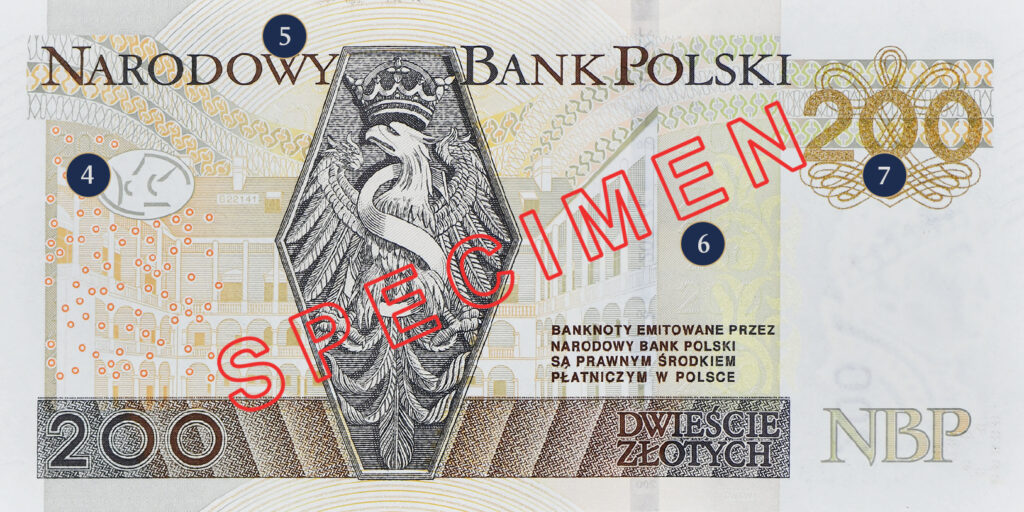
Characteristic elements of the modernised banknote:
- banknote size: 144 x 72 mm,
- The 200 zloty banknote features a portrait of King Sigismund the Elder,
- In an oval – a crown, the complete image of which can be seen when the banknote is held against the light (3),
- The shield smoothly changing colour from gold to green (4),
- The face value, portrait of the sovereign, emblem of the Republic of Poland and the signatures of the NBP Governor and the NBP General Treasurer are in raised print that is easy to feel, also for the visually impaired.

Watermark
When you look at the banknote against the light, the multitone watermark becomes visible as the repeat of the sovereign’s portrait on the front side and the light monotone value numeral “200” (filigree). The watermark field is free from print.
Security thread
When the banknote is held against the light, the whole security thread with microlettering: “200” and “200 ZŁ” is visible.
Security thread (windowed)
Fragments of the security thread are visible on the front of the banknote, and the whole security thread is visible when viewed against the light. When the banknote is tilted in vertical and horizontal directions, the colour changes smoothly from gold to green. The chessboard pattern moves in vertical and horizontal directions.
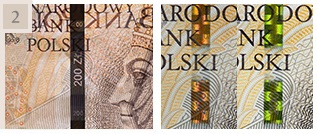
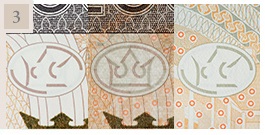
See-through register
The parts of the graphic design visible in the transparent light align perfectly to form a complete image – a crown in an oval.
Colour-shifting ink
When the banknote is tilted, the shield changes colour from gold to green, and the chessboard pattern on it moves in vertical and horizontal directions.

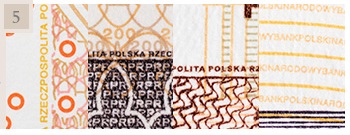
Microlettering
Tiny inscriptions made with high precision in offset or intaglio printing techniques. The smallest inscription on the banknote should be sharp and readable when magnified.
Iridescent ink
The ornament on the reverse of the is printed with iridescent ink in gold colour. When the banknote is tilted, the ornament is visible or almost invisible.


Gold ink
On the reverse of the banknote the value numeral “200” and decorative pattern below are printed in gold ink.
UV security features
A square with the value numeral “200” and abbreviation “ZŁ”, to the left of the portrait, serial number, the stripe on the bottom right-hand side of the sovereign’s portrait and some other graphic elements appear under UV light.
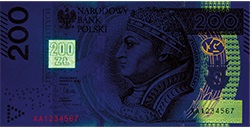
Description of 200 złoty banknote (previous issuance)
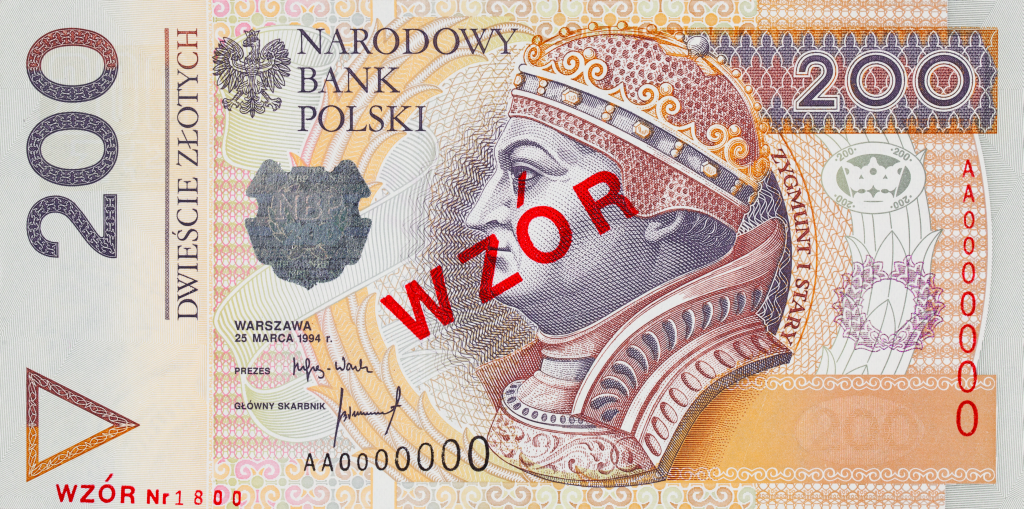
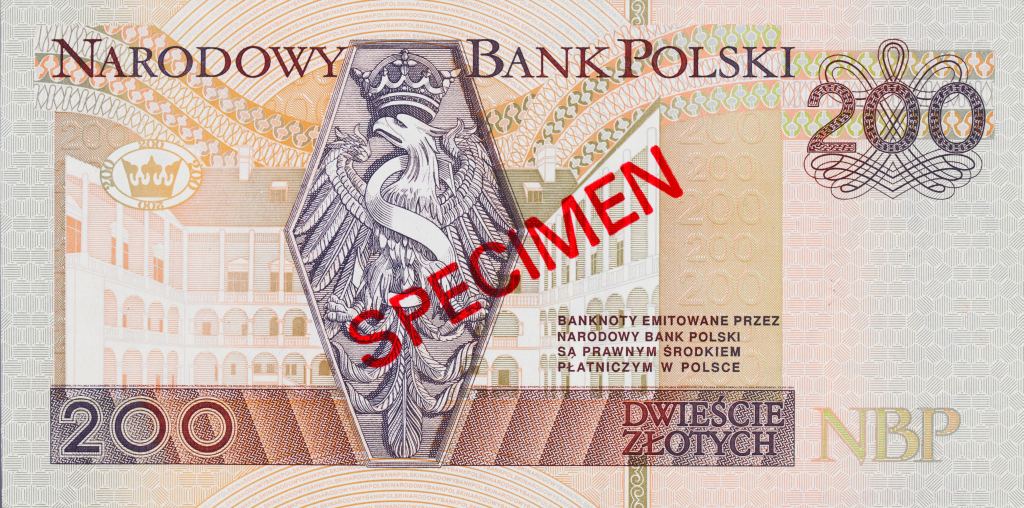
Format: 144 × 72 mm
Paper: white
Security features:
- watermark
portrait of King Sigismund I the Old - security thread
on left-hand side of note, with repeated inscription comprising denomination, “200 ZŁ”, and its mirror image - microlettering
front: : repeated vertical inscription, “RZECZPOSPOLITA POLSKA”, to right of watermark; repeated letters “RP” within separate field in background of number “200” on top right-hand side, with repeated inscription, “RZECZPOSPOLITA POLSKA”, above field
back: repeated inscription, “NARODOWY BANK POLSKI”, above and below depiction of eagle, in semicircles separated by lines, and repeated inscription, “RZECZPOSPOLITA POLSKA”, above lower field giving note’s denomination in numbers and words - fluorescence under UV light
front: square in willow green with inscription, “200 ZŁ”, in top left-hand corner; metallised ink in bottom right-hand corner in separate window, and fragments of guilloche background on right-hand side and in centre of note (all in yellow); serial number printed vertically in orange on right of note
back: guilloche ribbon in upper part of note, drawing of crown in oval, fragments of composition of guilloche lines making up repeated number “200”, fragment of lower separate field and part of initials “NBP” (all in yellow) - hologram
on front of note, to left of portrait, in shape of Renaissance cartouche, with large inscription, “NBP 200”, or small inscriptions, “NBP 200”, becoming visible depending on angle of vision - see-through register (recto-verso)
a crown in an oval next to the value numeral printed on both sides of the banknote as a combined image obtained when the banknotes are held against the light - latent image (angle effect)
crown in oval or number “200” become visible on front of note, in separate field on lower right-hand side, depending on angle of vision - metallised ink
on front of note, light brown and yellow colours in separate field in bottom right-hand corner - optically variable ink
on front of note, to right of portrait, small wreath below crown changes colour from pink-purple to olive-green depending on angle of vision
Serial number:
two upper-case letters and seven digits in ascending size on front of note, printed horizontally in black on lower left-hand side and vertically in red on right-hand side
Predominant colours:
- front – several shades of brown, light yellow, olive green
- back – several shades of brown, olive green
Front design:
Portrait of King Sigismund I the Old in centre area, enclosed to left by fragment of wreath interwoven with ribbon; to right of portrait – inscription, “ZYGMUNT I STARY”. Left of portrait – at top, depiction of eagle, emblem of Polish Republic, and inscription, “NARODOWY BANK POLSKI”; below that – hologram; below that – inscription, “WARSZAWA 25 MARCA 1994 r.”; below that – inscription, “PREZES”, and signature; below that – inscription, “GŁÓWNY SKARBNIK”, and signature. On left-hand side of note, in area of watermark – composition of guilloche lines. In top left-hand corner, arranged vertically – number “200”, with line underneath and inscription below, “DWIEŚCIE ZŁOTYCH”. In bottom left-hand corner – marking for the visually impaired, consisting of triangle with raised edges. Right-hand side of note contains two separate fields, upper and lower. Upper field bears number “200”, with drawing of crown in oval below and four “200”s around crown, and drawing of small wreath underneath. In background of crown and small wreath – fragment of large wreath. Lower field framed at top and bottom with white ornamentation. Number “200” in top left-hand corner, line below that, marking for the visually impaired and upper right-hand field are all filled with white ornamentation. Background of note consists of guilloche mesh with intersecting lines of light yellow, beige, light brown, olive green, light pink and light grey.
Back design:
Depiction of eagle intertwined with letter “S” in centre area, within hexagon from the Sigismund Chapel in cathedral on Wawel Hill. At top – inscription, “NARODOWY BANK POLSKI”. Below – rectangular field of ornamentation bearing number “200” to left and inscription, “DWIEŚCIE ZŁOTYCH”, to right. Above inscription – legend, “BANKNOTY EMITOWANE PRZEZ NARODOWY BANK POLSKI SĄ PRAWNYM ŚRODKIEM PŁATNICZYM W POLSCE”. To left of eagle – drawing of crown in oval and four “200”s around crown, with depiction of Wawel Castle courtyard forming background for eagle, and guilloche ribbon above. To left and right of courtyard, and in background of upper part of eagle – composition of guilloche lines making up repeated number “200”. In top right-hand corner – number “200” filled with white ornamentation, and in bottom corner – initials “NBP”. Area of watermark and margins printed with composition of guilloche lines.